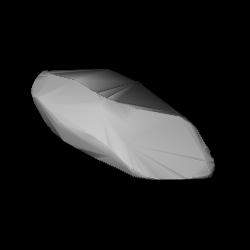 Shape model of Magnitka from its lightcurve | |
| Discovery [1] | |
|---|---|
| Discovered by | Crimean Astrophysical Obs. |
| Discovery site | Crimean Astrophysical Obs. |
| Discovery date | 12 October 1971 |
| Designations | |
| (2094) Magnitka | |
Named after | Magnitogorsk (Russian city) [2] |
| 1971 TC2 ·1941 WK 1951 WP ·1956 EB 1964 TD ·1968 WE 1977 FG | |
| main-belt · Flora [3] | |
| Orbital characteristics [1] | |
| Epoch 4 September 2017 (JD 2458000.5) | |
| Uncertainty parameter 0 | |
| Observation arc | 75.36 yr (27,524 days) |
| Aphelion | 2.4474 AU |
| Perihelion | 2.0170 AU |
| 2.2322 AU | |
| Eccentricity | 0.0964 |
| 3.34 yr (1,218 days) | |
| 149.03° | |
| 0° 17m 43.8s / day | |
| Inclination | 5.0289° |
| 281.93° | |
| 251.58° | |
| Physical characteristics | |
| 9.91±0.58 km [4] 10.121±0.408 km [5] 12.053±0.055 km [6] 12.167 km [7] 12.17 km (taken) [3] 12.58±1.04 km [8] 12.69±1.1 km [9] | |
| 6.11±0.02 h [10] 6.1124±0.0002 h [a] 6.24±0.01 h [11] | |
| 0.120 [3] [7] 0.1278±0.0129 [6] 0.132±0.025 [5] 0.1739±0.035 [9] 0.194±0.042 [8] 0.285±0.036 [4] | |
| S [3] | |
| 11.90 [8] ·12.0±0.2(R) [a] ·12.0 [4] [9] ·12.1 [1] ·12.45 [6] ·12.49±0.206 [7] ·12.49 [3] | |
2094 Magnitka (prov. designation: 1971 TC2) is a Flora asteroid from the inner regions of the asteroid belt, approximately 12 kilometers (7.5 miles) in diameter. It was discovered on 12 October 1971, at and by the Crimean Astrophysical Observatory in Nauchnyj, on the Crimean peninsula. [12] The discovery has not been attributed to an observing astronomer. It was later named for the city of Magnitogorsk. [2]
